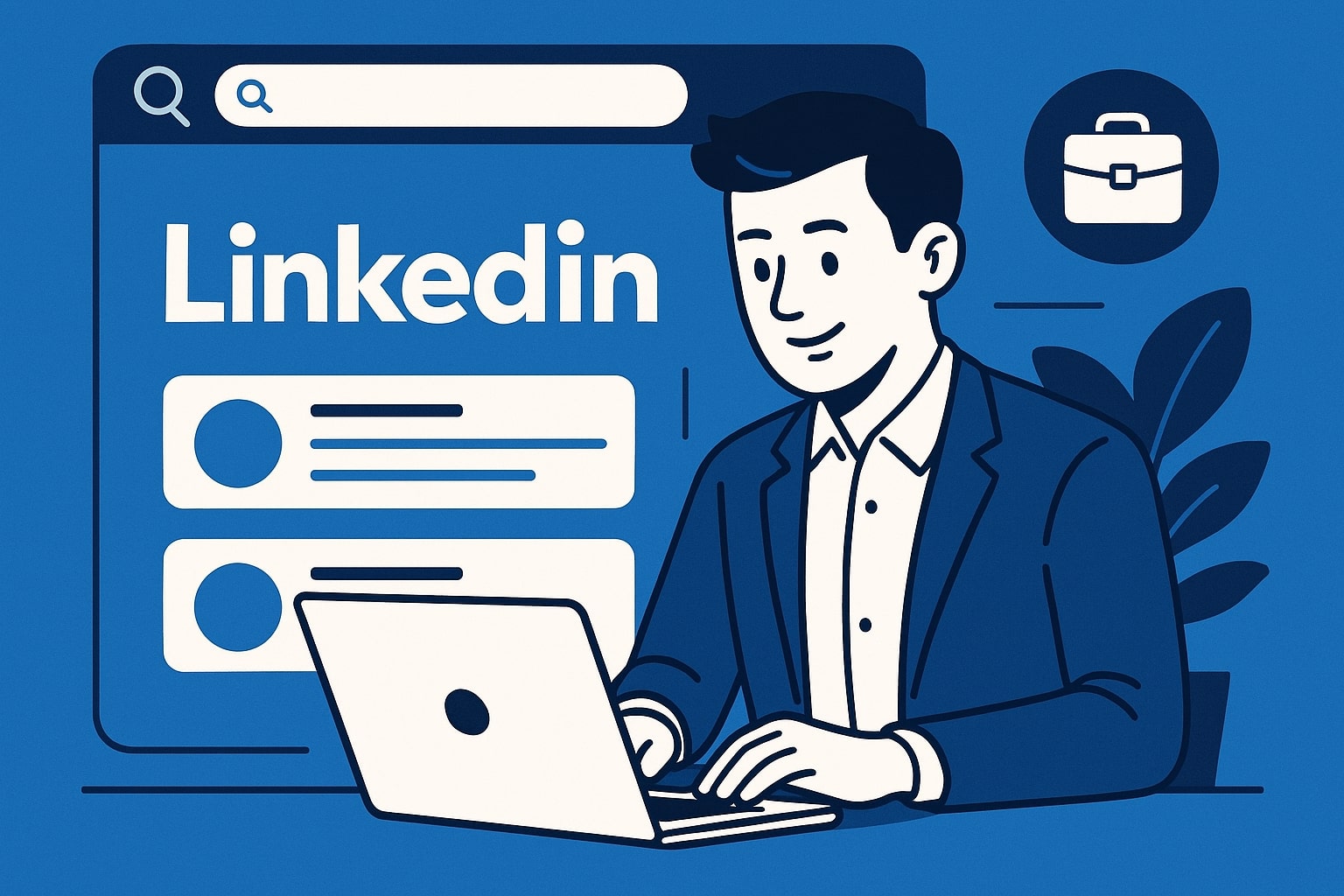Your LinkedIn About section is where your profile transforms from a resume into a story. It’s the only place on LinkedIn where you can write in your own voice, share what drives you, and connect with readers on a human level. Yet most professionals either leave it blank or fill it with corporate jargon that puts people to sleep.
If your About section starts with “Results-driven professional with extensive experience in…” you’ve already lost your reader. This guide will show you how to craft an About section that captivates, converts, and creates opportunities.
Why the About Section Is Your Secret Weapon
The About section sits prominently near the top of your profile, right after your headline and contact information. It’s one of the first things people read when deciding whether to connect with you, hire you, or reach out for collaboration.
Unlike the rigid structure of your Experience section, the About gives you creative freedom. You have 2,600 characters to paint a picture of who you are professionally, what you’ve accomplished, and where you’re headed. That’s roughly 400-450 words—enough space to tell a compelling story without overwhelming readers.
This section serves multiple strategic purposes. First, it humanizes you. Behind every profile is a real person with motivations, passions, and a unique perspective. Sharing yours creates connection and memorability. Second, it’s your SEO powerhouse. LinkedIn’s algorithm indexes every word in your About section, so keyword-rich content dramatically improves your discoverability. Third, it pre-qualifies opportunities by clearly stating what you do and who you help.
Consejo profesional: Profiles with completed About sections receive 30% more connection requests and significantly higher engagement than those without. Don’t leave this prime real estate empty.
The Fatal Mistakes That Ruin Most About Sections
Before we build your perfect About section, let’s identify the pitfalls that plague most profiles. Recognizing these patterns helps you avoid them.
Generic corporate speak is the number one killer. Phrases like “innovative team player,” “detail-oriented professional,” or “passionate about excellence” are meaningless filler. They could describe anyone in any industry. If you removed your name, would someone who knows you recognize this as your profile? If not, it’s too generic.
The resume copy-paste approach treats the About section like a chronological work history. That’s what your Experience section is for. Your About should provide context, themes, and the story behind your career moves—not list every job you’ve ever held.
Talking about yourself in third person creates unnecessary distance. “John is a marketing professional who specializes in…” feels stiff and impersonal. You’re not writing a press release. Use “I” statements to create genuine connection.
Other critical mistakes to avoid:
- No clear focus: Trying to appeal to everyone means appealing to no one
- Palabras clave faltantes: Invisible to recruiters searching for your expertise
- Too formal or too casual: Strike a balance appropriate to your industry
- Ending abruptly: No invitation to connect or clear next steps
| Error común | Por qué falla | What To Do Instead |
|---|---|---|
| Corporate buzzwords | Meaningless and forgettable | Use specific, concrete language |
| Reanudar la repetición | Boring and redundant | Tell the story behind your career |
| Third-person voice | Creates distance | Write in first person (“I” not “he/she”) |
| No personality | Fails to differentiate | Share your perspective and passion |
The Proven Structure for a Compelling About Section
Great About sections follow a narrative arc that draws readers in and guides them to action. Here’s the framework that consistently works across industries and experience levels.
Start with a hook (1-2 sentences). Your opening should grab attention immediately. Skip the boring introductions and lead with something unexpected, personal, or provocative. This could be a belief you hold, a problem you solve, or a moment that shaped your career path.
Examples of strong hooks:
- “I’ve always believed the best marketing doesn’t feel like marketing at all.”
- “Three years ago, I watched a preventable medical error change a patient’s life forever. That’s when I knew healthcare systems needed to change.”
- “Most people think data is boring. I think it’s the most powerful storytelling tool we have.”
Define who you are and what you do (2-3 sentences). Now that you have their attention, clearly establish your professional identity. What’s your role, your specialty, your focus? Be specific enough to be searchable but broad enough to be understood.
Share your journey or philosophy (2-3 sentences). This is where personality emerges. Why do you do what you do? What shaped your approach? What do you believe that others in your field might not? This section transforms your profile from informational to inspirational.
Highlight key accomplishments (3-5 bullets). Now prove you can deliver. Share specific achievements with quantifiable results when possible:
- “Increased revenue by 150% in 18 months through strategic partnership development”
- “Led a team of 12 engineers to deliver a product used by 2M+ users”
- “Published 50+ articles on cybersecurity with 500K+ combined reads”
- “Reduced operational costs by $2M annually through process optimization”
- “Grew email list from 5K to 100K subscribers in one year”
Describe your current focus (1-2 sentences). What are you working on now? What problems are you solving? This keeps your profile current and shows momentum.
Close with a clear call-to-action (1-2 sentences). Tell people exactly how to work with you or what kind of connections you’re seeking:
- “I’m always interested in connecting with fellow product leaders. Let’s share ideas!”
- “Looking for speaking opportunities on AI ethics? I’d love to hear from you.”
- “Open to consulting projects for scaling startups. Let’s talk.”
Writing Tips That Make Your About Section Shine
Once you understand the structure, these tactical tips will elevate your writing from good to great.
Use short paragraphs religiously. Aim for 2-3 sentences maximum per paragraph. Add line breaks liberally. White space is your friend—it makes content scannable and less intimidating. On mobile devices especially, dense text blocks cause immediate abandonment.
Include strategic keywords naturally. Think about what recruiters or potential clients might search for. If you’re a data scientist, include terms like “machine learning,” “Python,” “predictive analytics.” But weave them naturally into your narrative—don’t just list them.
Show, don’t just tell. Instead of “I’m a creative problem-solver,” tell a brief story about a problem you solved creatively. Instead of “I’m passionate about education,” explain why education matters to you and what you’re doing about it.
Add some personality (but stay professional). A touch of humor, a unique perspective, or an unexpected hobby can make you memorable. Just ensure it aligns with your professional brand. A corporate lawyer might mention marathon running; a creative director might share their obsession with vintage typography.
Make it skimmable. Busy readers should be able to grasp your value in 30 seconds. Use formatting like line breaks, short paragraphs, and occasional bold text (though use sparingly) to guide the eye to key information.
Real Transformation: Before and After
Let’s see these principles in action with a real example.
Before (Generic and Forgettable): “I am a seasoned marketing professional with over 10 years of experience in digital marketing, content strategy, and brand management. I am a results-driven individual who thrives in fast-paced environments. My expertise includes SEO, social media marketing, email campaigns, and analytics. I am passionate about helping companies grow their online presence and achieve their marketing goals.”
After (Compelling and Personal): “Most marketing feels like shouting into the void. I build strategies that feel like conversations.
Over the past decade, I’ve helped B2B SaaS companies transform their marketing from generic to genuine—the kind that attracts ideal customers instead of chasing everyone. My approach combines data-driven decision-making with storytelling that actually resonates.
Some highlights from my journey: • Grew organic traffic from 10K to 500K monthly visitors in 18 months • Built and led a content team that produced 200+ pieces driving $2M in pipeline • Developed SEO strategies that ranked for 150+ competitive keywords
Currently, I lead marketing for [Company], where we’re redefining how technical products communicate value to non-technical buyers. It’s the perfect intersection of my love for clear communication and complex problem-solving.
I’m always excited to connect with fellow marketers, startup founders, or anyone interested in the psychology behind great marketing. Coffee chat? Collaboration opportunity? Reach out—I’d love to hear from you.”
Notice how the transformation incorporates storytelling, specific achievements, personality, and a clear invitation to connect.
Your Next Steps: Craft Your Story Today
Your About section doesn’t need to be perfect on the first try. Start with the framework above, write freely without editing, then refine. Read it aloud—if it doesn’t sound like something you’d actually say, revise it.
Set aside 30 minutes today to draft your About section. Focus on authenticity over perfection. You can always update it as your career evolves, and you should—quarterly reviews keep your profile current and relevant.
Ready for expert feedback on your About section? Visit JobWinner’s Free LinkedIn Review feature to get instant analysis of your summary’s effectiveness. Our tool evaluates storytelling impact, keyword optimization, readability, and provides personalized recommendations to make your About section irresistible to your target audience.
Your story matters. Make sure it’s being told in a way that opens doors, creates connections, and moves your career forward. Those 2,600 characters might be the most important words you write this year.





